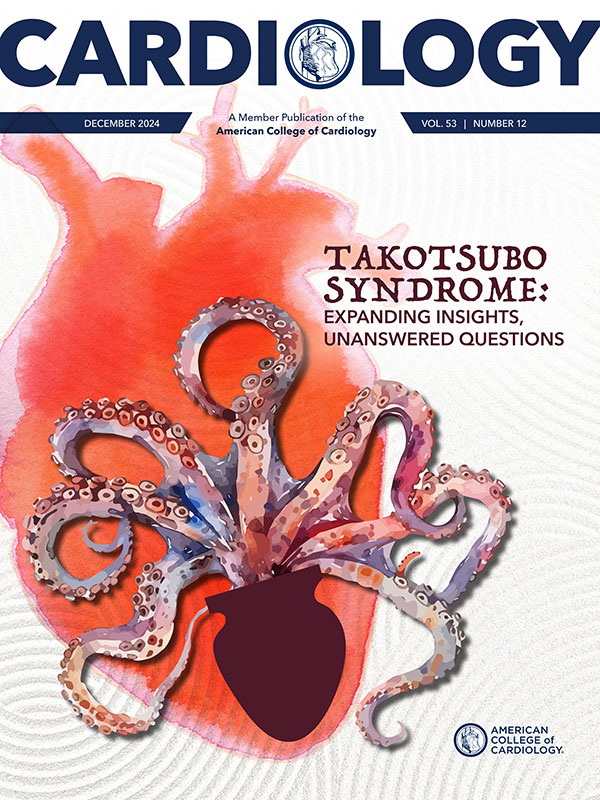Prioritizing Health | Heart Healthy Nutrition: An Opportunity to Improve Outcomes

Good nutrition is a fundamental component of cardiovascular care and the vast majority of cardiologists believe that dietary adjustments can greatly benefit patients with cardiac-related diseases. Yet, 59% of cardiologists reported spending less than three minutes discussing nutrition during patient encounters in a recent survey.1
Further, 90% reported minimal nutrition education during training, with only 1% believing themselves qualified to counsel patients. Notably, the words "nutrition" and "diet" are absent from the 38-page ACGME training rubric for cardiovascular disease.
A Call to Action
This disconnect between understanding, knowledge and practice, along with the recognition of the strong influence of a heart healthy diet in cinical guidance documents from the ACC, such as the 2023 guideline for primary prevention of cardiovascular disease and expert consensus decision pathway for heart failure,2,3 underscores a need for action.
Definitive steps to incorporate nutrition into daily cardiology practice are imperative, along with improving the nutritional quality of food served in hospital cafeterias and meal services. Here we outline actionable recommendations from an interdisciplinary perspective to address the nutrition deficiencies currently prevalent in hospital settings.
Manageable Change That Makes a Difference

Physicians, nurses, nutritionists and hospital administrators, as well as patients, play a crucial role in driving change to improve the nutritional quality of food in hospitals as part of being a true place of healing, as well as identifying malnutrition and food insecurity. Such screenings are a noninvasive and cost effective measure by which any health care professional can enhance patient health.
The need for nutrition screening to prevent adult malnutrition was reinforced in a recent survey of members of the American Society for Parenteral and Enteral Nutrition, Academy of Medical-Surgical Nurses and Society of Hospital Medicine.4
The survey also highlighted the need to increase the participation of physicians in this screening and the use of validated measures.
Of three common measures to assess malnutrition in hospitalized patients identified in a systematic review, the Patient Generated-Subjective Global Assessment was found to have superior diagnostic accuracy, reliability and internal validity.5
The Hunger Vital Sign, a two-question validated tool, can effectively identify food insecurity, ensuring proper education and resources are provided to improve patient outcomes.6,7
Importantly, the nutrition screening helps physicians to reinforce nutritional status as an essential attribute of the patient handoff and treatment plan and to involve nutritionists and nurses as essential team members.
While nutritionists help monitor patients' nutrition status and make changes, nurses functionally assume a first-line role, monitoring intake and eating challenges.8 This can help further individualize patient care.
Patients should be empowered to be their biggest advocate. Focusing on their intake and nutrition contributes to their own recovery. They should be encouraged to request assistance when unable to eat independently or ask family and friends to visit around mealtimes to maximize support.9
Sustained change requires the support of hospital management. A program in the U.K., protects patients from malnutrition by providing nutrient-dense, adequate food, meeting cultural and religious modifications, with assistance with food and liquid intake.10
To date, nutrition policies to this protective degree are sparse in the U.S. Two bills, one in New York and another in California, require plant-based, nutritionally adequate food options in hospital at patient request at no additional cost.11,12
Color-coded food trays to indicate the need for meal-time assistance13 and protected meal times to eliminate interruptions14 are feasible changes to help improve nutrition intake.
Overall, hospitals must invest in patient nutrition to reduce length of stay, readmission risk and costs.15
A New Model For Healthy Food

Health systems in the U.S. primarily serve a standard Western diet, high in animal fats and low in vegetables, fruits and other forms of fiber,16 with ultraprocessed foods associated with an increased risk of cardiovascular disease.17
While the American Medical Association has recommended more plant-based meals for patients, the Physicians Committee for Responsible Medicine emphasizes many U.S. hospitals still host fast-food restaurants onsite, offering processed meats and cheeseburgers to patients hospitalized for the very conditions fueled by these foods.18,19
Whole food, plant-based (WFPB) food options for patient meals and hospital cafeterias meet nutritional requirements and provide heart healthy food choices. Studies have shown this change is associated with an increase in self-rated health.20,21
Other studies have shown that WFPB diets lower BMI, cholesterol and HbA1c levels as well as improve depression and anxiety levels while controlling for similar levels of exercise and caloric intake.19,23 Thus, promoting WFPB foods as a default option for all hospitalized patients is enticing both for the immediate- and long-term management of chronic health conditions.
The University of Florida is leading in this arena, with its successful addition of a fully WFPB menu for its inpatient population – making them one of the first academic hospitals to make this institutional change. With U.S. hospitals already spending up to $1.7 million on food expenditures, their study showed no significant increase in food costs with WFPB options.23
Switching to WFPB options highlights the importance of hospital partnerships with local farms and policymakers to source fresh produce, a practice that has been proven successful. With the motto that good food powers good health, the Partnership for a Healthier America, started by former first lady Michelle Obama, provides healthier hospital food options and eliminates unhealthy snack foods; as of 2017, it has been adopted by (only) 10% of U.S. hospitals.24
The Healthy Hospital Food Initiative aimed at revamping hospital menus and screening for basic nutrition standards, led by the New York City Department of Health and Mental Hygiene, has been adopted by two-thirds of New York City hospitals.26
Farm-to-hospital programs or onsite farmer's markets can extend the options for healthy eating habits by sourcing from the local community, a strategy undertaken in Wisconsin that ultimately led to increased clinic purchases of fresh produce.26-28
Practical steps for bringing WFPB options into a hospital include small-scale farm-to-hospital initiatives and training staff to implement new nutrition standards. Committing to providing healthier food options, and monitoring and evaluation, are crucial to improve hospital care and heart health for all.
This article was authored by Adithi A. Tirumalai, BS, University of Central Florida College of Medicine, Orlando; Kai Snodgrass, Winter Park High School, Orlando; Columbus D. Batiste, MD, FACC, Kaiser Permanente Southern California; and Andrew M. Freeman, MD, FACC, National Jewish Health, Denver, CO.
References
- Devries S, Agatston A, Aggarwal M, et al. A deficiency of nutrition education and practice in cardiology. Am J Med 2017;130):1298-1305.
- Members WC, Virani SS, Newby LK, et al. 2023 AHA/ACC guideline for the management of patients with chronic coronary disease. J Am Coll Cardiol 2023;82:833-955.
- Kittleson MM, Panjrath GS, Amancherla K, et al. 2023 ACC expert consensus decision pathway on management of heart failure with preserved ejection fraction. J Am Coll Cardiol 2023;81):1835-18.
- Patel V, Romano M, Corkins MR, et al. Nutrition screening and assessment in hospitalized patients: A survey of current practice in the United States. Nutr Clin Pract 2014;29:483-90.
- Xu YC, Vincent JI. Clinical measurement properties of malnutrition assessment tools for use with patients in hospitals: A systematic review. Nutr J 2020;19:1-12.
- Berkowitz SA, Seligman HK, Meigs JB, Basu S. Food insecurity, healthcare utilization, and high cost: A longitudinal cohort study. Am J Managed Care 2018;24:399.
- Byker Shanks C, Gordon NP. Screening for food and nutrition insecurity in the healthcare setting: A cross-sectional survey of non-medicaid insured adults in an integrated healthcare delivery system. J Prim Care Community Health 2024;15:21501319241258948.
- Tappenden KA, Quatrara B, Parkhurst ML, et al. Critical role of nutrition in improving quality of care: An interdisciplinary call to action to address adult hospital malnutrition. J Acad Nutr Diet 2013;113:1219-37.
- Laur C, McCullough J, Davidson B, Keller H. Becoming food aware in hospital: A narrative review to advance the culture of nutrition care in hospitals. Paper presented at: Healthcare 2015.
- Care Quality Commission. Gov.UK. The State of Health Care and Adult Social Care in England: Key Themes and Quality of Services in 2009. Avalable here.
- New York State Senate. Hoylman-Sigal B. Senate Bill S1471a. Available here.
- California Legislative Information. SB-1138 food options: Plant-based meals. Available here.
- Bradley L, Rees C. Reducing nutritional risk in hospital: The red tray. Nursing Standard 2003;17:33.
- Young AM, Mudge AM, Banks MD, et al. Encouraging, assisting and time to eat: Improved nutritional intake for older medical patients receiving protected mealtimes and/or additional nursing feeding assistance. Clin Nutr 2013;32:543-49.
- Congress. gov. H.Res.1118 - Expressing the sense of the House of Representatives that the United States recognizes the mounting personal and financial burden of diet-related disease in the United States and calls on medical schools, graduate medical education programs, and other health professional training programs to provide meaningful physician and health professional education on nutrition and diet. Available here.
- Aggarwal M, Grady A, Desai D, et al. Successful implementation of healthful nutrition initiatives into hospitals. AmJ Med 2020;133:19-25.
- Srour B, Fezeu LK, Kesse-Guyot E, et al. Ultra-processed food intake and risk of cardiovascular disease: Prospective cohort study (nutrinet-santé). BMJ 2019;365.
- Murphy T. The Role of Food in Hospitals. HealthCareCAN May 2017. Available here.
- Storz MA. Should plant-based hospital meals be the law? An American experience. 2020:48:241-43.
- Reidlinger DP, Darzi J, Hall WL, et al. How effective are current dietary guidelines for cardiovascular disease prevention in healthy middle-aged and older men and women? A randomized controlled trial. Am J Clin Nutr 2015;101:922-30.
- Massar RE, McMacken M, Kwok L, et al. Patient-reported outcomes from a pilot plant-based lifestyle medicine program in a safety-net setting. Nutrients 2023;15:2857.
- Salehin S, Rasmussen P, Mai S, et al. Plant based diet and its effect on cardiovascular disease. Int J Environ Res Public Health 2023;20:3337.
- Saldivar B, Al-Turk B, Brown M, Aggarwal M. Successful incorporation of a plant-based menu into a large academic hospital. Am J Lifestyle Med 2022;16:311-17.
- Simon C, Kocot SL, Dietz WH. Partnership for a healthier america: Creating change through private sector partnerships. Current Obesity Reports 2017;6:108-15.
- Moran A. An intervention to increase availability of healthy foods and beverages in new york city hospitals: The healthy hospital food initiative, 2010-2014. Prev Chronic Dis 2016;13.
- Harris D, Lott M, Lakins V, et al. Farm to institution: Creating access to healthy local and regional foods. Adv Nutr 2012;3:343-49.
- Morales A. Farm-to-hospital programs and public health: Leveraging local food for organizational and behavioral change. J Agriculture Food Systems Community Development 2022;11:243-261.
- Morales A. The potential impact of hospital cafeterias on dietary habits: A case study of the university of wisconsin hospitals and clinics. WMJ 2020;119:122-25.
Clinical Topics: Cardiovascular Care Team, Diabetes and Cardiometabolic Disease, Prevention, Diet
Keywords: Cardiology Magazine, ACC Publications, Nutritional Status, Malnutrition, Primary Prevention, Diet, Healthy, Healthy Diet
